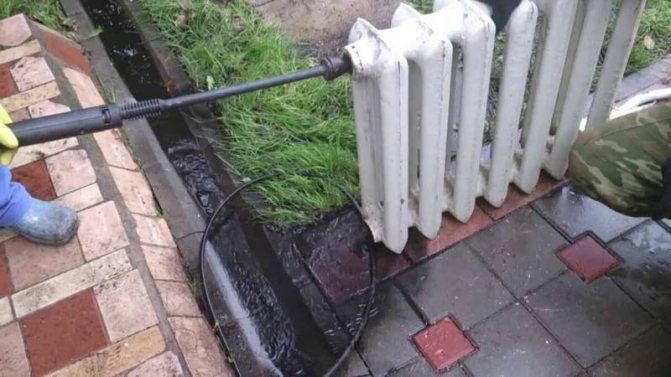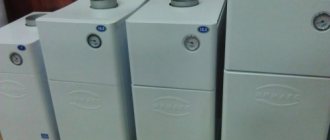Clogged battery
Due to the poor quality of the heating medium supplied to heating systems, blockages are becoming a very common cause of poor heating. The issue becomes especially relevant during the start of the heating season. In private houses, the system is autonomous, and its clogging can only occur through an open-type expansion tank.

Clogged battery
To clean the battery, disconnect it from the pipes and rinse it. The first time hot water is poured, then special solutions can be used.
https://youtu.be/2U605ajrb6w
Troubleshooting with your own hands (step by step instructions)
The reasons for the malfunctioning of the heating system, which are indicated by a large difference in the temperature of the top and bottom of the radiator, are considered. It remains to decide on a plan of action when they occur. Immediately, it should be noted that it is impossible to eliminate some problems on your own. If you feel cold in the room and find a strong difference in temperature between the upper and lower parts of the battery, you need to perform a number of measures in order.
- Check and fully open the inlet and outlet valves on the battery pipes. If a malfunction is found, the out-of-order components of the shut-off valves being repaired should be replaced or replaced completely if repair is not possible.
- Bleed the airlock from the battery, if there is a valve or faucet, by placing a suitable container for the liquid and being careful. In the presence of air, water from the tap will burst out in jerks with a characteristic hiss.
- If air relief did not help, you can proceed to checking and, if necessary, cleaning the radiator from internal contamination. After closing the taps on the pipes and placing a suitable container under the radiator, unscrew the drain plug, the presence of contamination will be indicated by a flowing dark brown substance (almost black).
- If there is no dirt, no air, and provided that before the start of the heating season, any plumbing work was carried out on the heating system, you should check the correct connection of the radiator. If you find an incorrect installation yourself or by calling the masters from the house service company, you must bring the battery installation in accordance with the approved scheme.
- With low pressure and low circulation rate of the working fluid, when all other checks and measures have been carried out, you need to call the management company or the organization that supplies the heat to find out the deadline for eliminating the problem.
- If the room is cold, then it is advisable to wait until it warms up, it is possible that during the absence of the owner, the central heating was turned off for some reason. As the room warms up, the difference in heating between the top and bottom may return to normal.
The most important thing is to remember about safety measures, since hot water under pressure can not only damage the surrounding interior, but also harm health.
The video clip shows the process of bleeding air from the radiator.
Air congestion
Air in the system is the main reason the bottom of the battery is cold and the top is hot. Most often, this trouble is observed among residents of apartment buildings on the upper floors. The air in the system tends upward, therefore, living in the upper part of the building, Mayevsky taps or downpipes should be installed.
You can read about how to bleed air from a cast iron battery here.


Mayevsky crane
The sequence of actions will be as follows:
- Shut off the pipe that supplies hot water to the radiator. In this case, the "return" must remain open.
- Open the vent and wait until the air is completely out of the system.
- Close the drain and restart the water supply to the radiator.
In a private house, you can use an alternative scheme:
- Shut off the heating supply.
- Open the drain at the top of the heating system.
- Remove trapped air by back pressure.
If these recommendations did not bring the expected result, it is better to call a specialist to diagnose the entire system as a whole.


Air vent in new batteries
How can it be dangerous


Radiators can become cold due to the fact that neighbors "quietly" installed a water underfloor heating from a central high-temperature heating
The uniformity of heating radiator batteries directly depends on the balance of the speed of the heat carrier and its temperature regime.
Improper operation of the heating system can cause:
- quite strong and unpleasant noise and vibration;
- violation of the acid-base balance of the heat carrier;
- enhancing the corrosive effect on heating elements;
- noticeable reduction in service life, as well as failure of the batteries.
Breakage of shut-off valves
Shut-off valves are designed to completely or partially cut off the coolant supply to the batteries. Its main components are:
- Ball Valves;
- valves;
- thermal heads equipped with a mechanical or automatic regulation system.


Ball valve design
The bottom of the battery is cold, and the top is hot due to a malfunction inside the tap. This may be due to a breakaway flap or any other violation of the correct operation of the element, which violates the free circulation of the liquid. Also pay attention to the correct mounting direction of the valve. The manufacturer indicates the direction of movement of water on the body and installation should be carried out according to it. In case of incorrect installation, water will not move through the pipe even in the open position of the shut-off valve.


Direction of movement of water in the valve
Some cranes require correct positioning in space. For example, strictly horizontal or vertical arrangement.
Why does the battery have a hot top and a cold bottom
Almost all batteries have a hot top and a cold bottom. These are the operational features of radiators. They are associated with a large percentage of heat transfer in the heating system. The liquid inside cools down before moving further through the pipes. But the difference in temperature should not be significant. According to the standards - no more than 5 degrees. For self-measurement, you can use a special thermometer (mercury or electronic) so that its scale is calculated up to +80 degrees and above. Just attach the part of the thermometer containing mercury to the radiator, fix it and wait for the result.


With the help of thermometers for heating radiators, you can understand if there is a problem with the battery. If the temperature difference between the top and bottom of the radiator is no more than 5 degrees, this is an operational feature.
However, if the battery at the bottom is very cold, at the top it is too hot, then the point is not in the technical characteristics of the equipment. Most likely, the reason is the following:
- during the installation of the heating system, the installer confused the pipelines that are responsible for the supply and return of the internal fluid (water, oil, antifreeze);
- the liquid circulates too slowly inside the structure, it cools down on the way to the coolant and at the moment it leaves the battery it becomes icy;
- the pressure in the heating system has dropped.
If the structure is connected incorrectly, then as a result:
- the circulation of fluid in the system is disturbed;
- efficiency is approaching zero;
- liquid does not enter all sections without exception, which is necessary for the normal operation of the battery;
- water, oil or antifreeze does not come out at all or leaves the radiator unevenly;
- high pressure is created inside the heating system, which can lead to rupture of pipes and connections.
Low pressure
The bottom of the battery may be colder than the top due to insufficient pressure in the system. If the main system is designed for cast iron pipes, then the water supply force in it is quite low. The installation of bimetallic batteries leads to the fact that the coolant simply does not push through the narrowed passages inside the radiator.
In a private house with a membrane expansion tank, the pressure in the system can be raised manually. Residents of apartment buildings will have to contact a service provider to resolve the issue. Also, repair work can be carried out on the central highway, after which everything will return to normal.


Pressure gauge showing system pressure
The bottom of the battery is often cold and the top is hot due to illegal actions of neighbors of an apartment building:
- Installation of water-type underfloor heating.
- The bypass was installed on a common heating supply pipe.
- The volume of radiators has been increased without agreement with the technicians.
Incorrect pipe connections
Improper pipe connections reduce the efficiency of the radiator. Using the services of experienced craftsmen, this problem does not arise. However, if you decide to connect the pipes yourself, then you may be making a major mistake. When installing a radiator, a return pipe is often attached to the upper branch pipe, and for supply to the lower one. As a result of this error, the following problems arise:
- The efficiency of the system decreases and the water circulation is completely destroyed.
- The process of removing water from the battery is disrupted.
- Due to a decrease in the efficiency of the battery, as well as heat transfer, water cannot fill all sections evenly.
Water enters the radiator through the bottom pipe. Then it flows in a circle and is removed from the radiator. The work of the radiator is significantly reduced, since the sections do not warm up well. When connected to the top nozzle, no liquid is discharged from the inside. This is due to the characteristics of the radiator, which cannot create high pressure to remove water through the top.
Since cold water has a lower density than cold water, when it enters the radiator, it tends to the top. The coolant travels a shorter path, while the liquid in the sections does not move.
If you have connected the radiator correctly, then the water should come from the top and flow through the upper manifold. The liquid will flow into the columns, and pass to the bottom, since the pressure in the radiator is low. When working properly, the radiator will heat up evenly.
If, nevertheless, the pipes were connected incorrectly, there are several options for how to fix the situation:
- Disconnect the pipes;
- Establish the correct scheme of work, in which the supply pipe is connected to the upper branch pipe, and the return pipe to the lower one;
- After completing the previous steps, you can connect all the elements to the radiator, and then check its operation.
If you are sure that you have connected the pipes correctly, and the radiator still remains cold from below, then you should look for other causes of the problem.
Low speed of movement of the coolant
If the hot water moves through the pipes quickly enough, then it will give off heat more evenly along the entire length of the system. Otherwise, the radiators at the end of the line will be much colder than at the beginning.
Concerning high-rise buildings: The problem can be solved by connecting the battery diagonally. This will ensure an even flow of fluid throughout the radiator.


Diagonal battery connection
In a private house a malfunction of such a plan may arise due to a breakdown or absence of a circulation pump. You should check its correct operation. If the system is built on the gravitational principle of fluid movement, then it is recommended to install an additional pump. This will ensure that the radiators warm up evenly throughout the house.


Circulation pump in the heating system
Another reason that the bottom of the battery is cold and the top is hot can be a narrowing of the pipeline. This also leads to a low speed of movement of the coolant. The pipeline is narrowed if:
- The plastic pipes were poorly welded and part of the passage is obstructed by the molten structural element.


Bad soldering of plastic pipes - Too much deposits have formed on old iron pipes.


The bottom of the battery is cold and the top is hot due to deposits - The control valve has a narrowed inner section.
This article covered the main problems that lead to insufficient heating of the bottom of the battery. Most of the problems are solved on their own and require little effort. However, some system deficiencies, such as pipe build-up, may require replacement of the entire pipeline.
(1 estimates, average: 5,00 out of 5)
Share this:
How do I clean clogged batteries?
To avoid a situation when the radiators are cold from below and hot from above, they need to be periodically cleaned:
- To clean the radiator, it will have to be removed and rinsed. The best place for this would be the street or the bathroom.
- If you plan to clean in the bathroom, protect the drain from blockages and the bathroom from scratches.
- Turn off the water, remove the radiator, drain all liquid.
- To remove the rust, tap the battery through a thick cloth, then shake out the debris.
- It will not be superfluous to rinse the battery with a hose under pressure in order to properly clean it of accumulated rust.
- For prevention, you should clean all the radiators in the apartment, and not just those where the lower part of the battery is cold and the upper one is hot.
- Be careful when cleaning the battery. If you doubt that you will be able to cope with this work, then it is better to consult a specialist.
Now you know what to do if the top of the battery is hot and the bottom is cold. On our website you can find out where to complain about cold batteries in an apartment in Moscow.
Low coolant temperature
The reason for the cold batteries may be the interference of neighbors in the heating system of the house. The most common violation in this area is an increase in the number of batteries or its sections, a change in the diameter of the distribution pipelines, and new connection schemes. All this leads to overcooling of the water leaving the apartment and an imbalance in the operation of the heating system. The coolant can no longer heat the next apartment to the required temperature.
If the temperature of the batteries is 30–40 degrees and the movement of water is heard in the radiator, then the boiler room may not be able to cope with the load. It is necessary to call the heat generating company and clarify the situation.
Why are the batteries in the apartment not warming up well?
Reason 1: air locks
Often the batteries in the apartment are cold or not warm enough due to air congestion. As a rule, such a problem is relevant for residents of the upper floors, since the air tends upward through the pipes. In order to eliminate air congestion, a Mayevsky crane is used. It allows you to release the collected air and ensure full circulation of the coolant in the pipes.
Reason 2: suboptimal connection of heating batteries
The first sign of improper connection is uneven heating of the battery. The radiator will not heat up strongly enough if the water supply is from the bottom. It is best in this case to change the connection diagram from side or bottom to diagonal.
Reason 3: a large number of radiator sections
Uneven and weak heating of the radiator may be the result of too many sections. It is best to avoid installing the battery in more than 12 sections.
Reason 4: low coolant temperature
Sometimes the batteries remain cold in winter due to the low temperature of the coolant (water) itself. In this case, you must contact the house management.
























